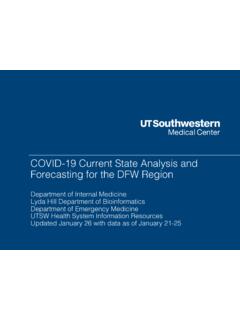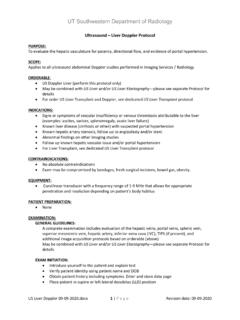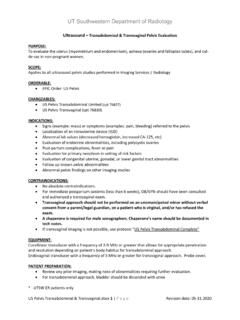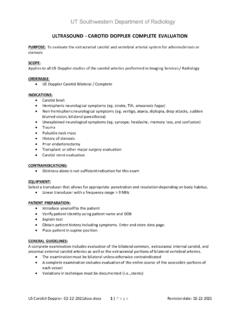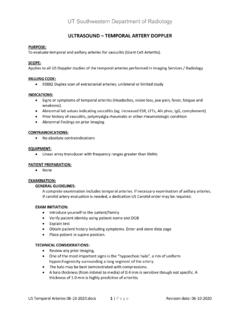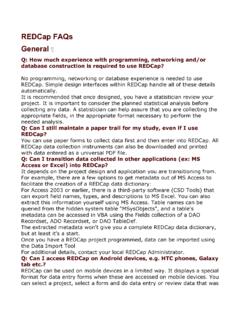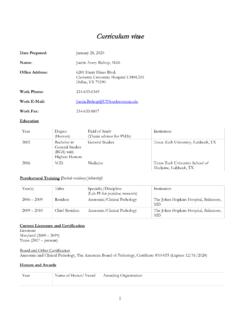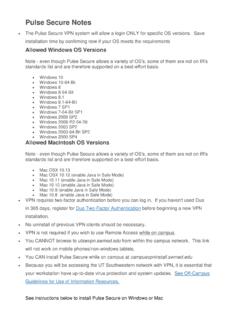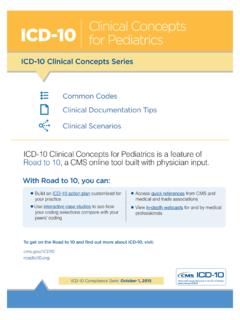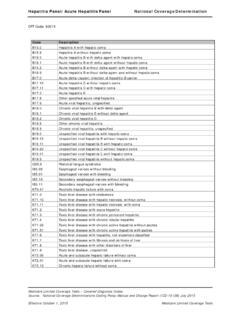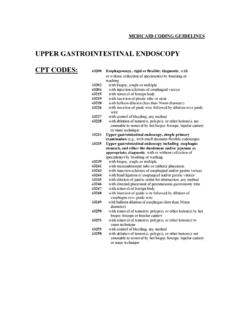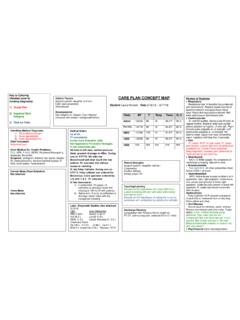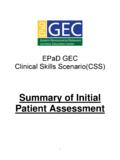Transcription of Ultrasound – Limited Abdomen of Right Upper Quadrant
1 UT Southwestern Department of Radiology Ultrasound Limited Abdomen of Right Upper Quadrant PURPOSE: To evaluate the Right Upper Quadrant (RUQ) including the liver, gallbladder, bile ducts, pancreas, and Right kidney. SCOPE: Applies to all US Abdomen RUQ studies performed in Imaging Services / Radiology ORDERABLE: US Abdomen Limited (RUQ). CHARGEABLES: US Abdomen Limited (CPT 76705). INDICATIONS: Signs or symptoms (eg. pain ) referred to Right Upper Quadrant or Right flank;. Abnormal lab values (examples: increased LFTs, amylase/lipase, etc);. Abnormal findings on other imaging studies;. Follow up known abdominal or retroperitoneal abnormalities;. For cirrhosis/chronic liver disease and HCC screening, evaluation of portal hypertension/ascites, or jaundice, consider order change to US Liver (and reference appropriate protocol). CONTRAINDICATIONS: No absolute contraindications EQUIPMENT: Curvilinear array transducer with a frequency range of approximately 1-9 MHz that allows for appropriate penetration and resolution depending on patient's body habitus.
2 PATIENT PREPARATION: Patient should be NPO for 4-6 hours prior to study, allowing for distention of gallbladder and decrease in bowel gas. EXAMINATION: GENERAL GUIDELINES: A complete examination includes evaluation of the entire liver, gallbladder/bile ducts, pancreas, and Right kidney. For cirrhosis/chronic liver disease and HCC screening, evaluation of portal hypertension/ascites, or jaundice, consider having order changed to US Liver (and reference appropriate protocol). EXAM INITIATION: Review any prior imaging, making note of abnormalities requiring evaluation. Introduce yourself to the patient Verify patient identity using patient name and DOB. Explain test US Abdomen Limited (RUQ) Revision date: 06-01-2020. 1|P a ge UT Southwestern Department of Radiology Obtain patient history including symptoms. Inquire if the patient has received pain medication. Enter and store data page Place patient in supine and/or left lateral decubitus (LLD) positions TECHNIQUE CONSIDERATIONS: Review any prior imaging, making note of abnormalities requiring evaluation.
3 Deep inspiration facilitates imaging of the liver dome, Right hepatic lobe, and Right kidney in the supine position via subcostal approach. In LLD position, the liver, gallbladder, and Right kidney shift towards the midline, improving accessibility for scanning and facilitating intercostal scanning for the posterior liver. Liver: o Liver should be evaluated for focal and/or diffuse abnormalities. Liver echogenicity should be compared with that of the Right kidney and pancreas. o Cine sweeps, including as much hepatic parenchyma as possible, should be acquired in the transverse and longitudinal orientations. o Evaluate the parenchyma adjacent to the gallbladder fossa, fissure for the falciform ligament, and portal bifurcation for areas of focal fatty sparing. o In the absence of ascites, nodular liver surface contour is best seen with a linear array transducer. o * Evaluate the area around the ligamentum teres for a dilated paraumbilical vein in the setting of portal hypertension Gallbladder and Bile Ducts: o Fasting for 6-8 hours prior to exam will permit adequate distension.
4 O Gallbladder and intra/extrahepatic bile ducts should be evaluated for dilatation, wall thickening, and intraluminal findings. Color Doppler may be used to differentiate hepatic arteries and portal veins from dilated intrahepatic bile ducts o In addition to supine and/or LLD imaging, upright or prone imaging of the gallbladder may be necessary to evaluate mobility of sludge and stones or to differentiate them from a polyp. o Evaluation for a sonographic Murphy sign requires focal tenderness to transducer compression immediately over the gallbladder, in an unaltered patient and in the absence of the patient having received pain medication. This should be distinguished from diffuse abdominal tenderness. o The common duct should be imaged longitudinally, adjacent to the main portal vein, distinguished from the hepatic artery by color Doppler. o The duct should be measured from inner wall to inner wall at the porta hepatis near the crossing of the Right hepatic artery.
5 Remainder of the common duct should be evaluated as far distally toward the pancreatic head as possible if common duct measurement is abnormal or for obvious choledochocele variant, with an evaluation for obstructing intraluminal or extrinsic lesions, if possible. Pancreas: o Pancreas should be evaluated for diffuse and/or focal abnormalities, pancreatic duct dilatation with diameter measurement (if visualized), and for peripancreatic adenopathy or fluid. US Abdomen Limited (RUQ) Revision date: 06-01-2020. 2|P a ge UT Southwestern Department of Radiology o Air in the transverse colon and small bowel may obscure the pancreas and may be displaced by graded transducer pressure. Orally administered water may afford better visualization of the pancreas via RLD approach through the distal stomach. Right Kidney: o Examine the Right kidney from an anterolateral or direct lateral approach in the supine or LLD position with the liver as a sonographic window o Renal echogenicity (in comparison to liver), cortex, pelvis, and the perirenal region should be assessed for abnormalities on real time survey.
6 O Color/Power Doppler should be used to assess for uniform parenchymal perfusion, and to evaluate for twinkling artifact seen with renal calculi. DOCUMENTATION: Pancreas o Transverse images: Representative images of the head/uncinate, neck, body, and tail, with cine sweep of any focal abnormality. Measure pancreatic duct, if visualized. If dilated, image duct as close to pancreatic head as possible. Liver o Longitudinal images (minimum): LEFT LOBE. Left lobe left of midline Left lobe at midline. Include proximal abdominal aorta Left lobe with IVC. Include caudate lobe, MPV, and pancreatic head. Left lobe with left portal vein CINE CLIP: from lateral tip to IVC/ Right of midline Right LOBE. Right lobe with gallbladder Right lobe with Right kidney Right lobe including Right hemi-diaphragm and pleural space Right lobe far lateral CINE CLIP: from midline to lateral most margin, using multiple acoustic windows if necessary. o Transverse images (minimum): Dome with hepatic veins LEFT LOBE.
7 Left lobe dome Left lobe with left portal vein Left lobe inferior tip CINE CLIP: from dome to inferior most margin Right LOBE. Right lobe dome Right lobe with Right portal vein Right lobe with main portal vein Right lobe with gallbladder US Abdomen Limited (RUQ) Revision date: 06-01-2020. 3|P a ge UT Southwestern Department of Radiology Right lobe with Right kidney Right lobe near liver tip CINE CLIP: from dome to inferior most margin, using multiple acoustic windows if necessary o *Liver Capsule (if liver disease suspected). With a linear 9, 12, or 18 MHz transducer, include high-resolution images of hepatic capsule and underlying parenchyma for nodularity, both left lobe and Right lobe (if visualized well), TRV and LONG. CINE CLIP in LONG during breathing cycle (inhalation and exhalation), with probe stationary, from both left lobe and Right lobe (if visualized well). o Doppler (for all exams): Main portal vein Color Doppler (Dual/Split screen with grayscale).
8 Gallbladder and Bile Ducts o Common duct with largest diameter measurement at porta hepatis. o Gallbladder: Longitudinal images: Representative images of gallbladder, including the neck, mid body, and fundus, CINE CLIP. Transverse images: Representative images of gallbladder at neck, mid body, and fundus CINE CLIP, porta hepatis to fundus REPEAT IMAGES IN LLD. o Gallbladder, long and transverse, looking for mobile stones/biliary precipitate (sludge). Standing or even RLD or prone imaging may be needed to differentiate a mobile from impacted gallstone o Repeat TRV images of hepatic dome o Repeat Long images of Right lateral margin of Right lobe o Repeat any images of areas not see well supine Kidney ( Right ). o Longitudinal images: Far Medial Mid segment Without and with longitudinal measurement Without and with color Doppler if pelvicaliectasis is suspected Far Lateral CINE CLIP: Entire kidney Cine clip through any focal abnormality Color Doppler: Image(s) of parenchyma to show homogeneous perfusion o May need separate color Doppler boxes of Upper pole, mid kidney, and lower pole US Abdomen Limited (RUQ) Revision date: 06-01-2020.
9 4|P a ge UT Southwestern Department of Radiology o Color Doppler image of any suspected echogenic focus for twinkling artifact o Transverse images: Upper pole Upper mid Mid Lower mid Lower pole CINE CLIP: from above Upper pole through lower pole Cine clip through any focal abnormality PROCESSING: Review examination images and data Export all images to PACS. Confirm data in Imorgon (where applicable). Document relevant history, if the patient was altered or received pain medication prior to the examination, and any study limitations REFERENCES: ACR-AIUM Practice Guideline (Revised 2007). REVISION HISTORY: SUBMITTED BY: David T. Fetzer, MD Title Medical Director APPROVED BY: David T. Fetzer, MD Title Medical Director APPROVAL DATE: 11-22-2015. REVIEW DATE(S): 11-12-2018 David T. Fetzer, MD. REVISION DATE(S): 04-18-2018 Brief Summary Add info on liver cine sweeps. Included info to direct operator to US. Liver in cases of suspected liver disease, portal hypertension, HCC screening 11-12-2018 Brief Summary Included use of Color Doppler in eval of Right kidney 12-11-2019 Brief Summary Adjusted Documentation section to reflect preferred order of image acquisition.
10 02-23-2020 Brief Summary Clarifications regarding cine sweeps needed through liver. Removed liver length measurement 06-01-2020 Removed unnecessary still images of kidney and pancreas US Abdomen Limited (RUQ) Revision date: 06-01-2020. 5|P a g

